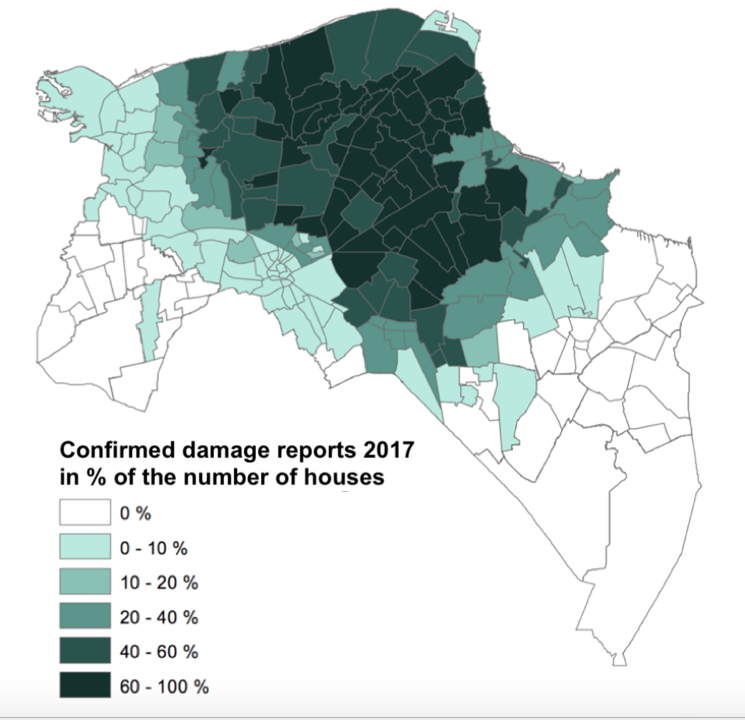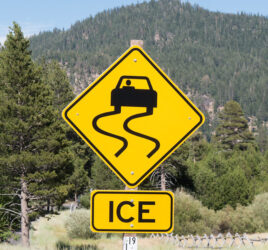
Fear and trembling in Groningen
For the past years, Katherine Stroebe, Babet LeKander, Justin Richardson and a host of colleagues inside the department in collaboration with external partners have been accumulating a wealth of data to document the societal impact of the earthquakes induced by gas extraction. In this piece, I go beyond the evidence itself and offer an opinion on the safety policy in Groningen. There are three aspects to the safety of residents in the region:
- what those residents tell us, in our research, about the threats to safety that they feel exposed to and (as shown by our studies) suffer from
- what the “real” and relevant safety risks are according to safety experts
- what the hidden risks and costs are for the solution that the government is implementing to safeguard safety
Background
Groningen suffers from earthquakes and rumoured soil instability due to gas extraction. For a long time this was neglected and denied: the magnitude of the earthquakes looks reassuringly small on paper (most of them are no more than 2.5 or so. The biggest one was a magnitude 3.6). Geologists simply could not believe the rumours of damage. But the combined impact of many small earthquakes (there have been over a thousand) has been huge. Moreover, the earthquakes happen at a very shallow depth and the impact is enlarged by the fact that the top soil in the low countries is so boggy: a tsunami-like wave is thought to be responsible for a lot of the damage. Fact is that, by now, an estimated 100.000 instances of damage to homes and property have been reported. Fact is also that until now, over one billion euro has been spent on repairs. The major concern is: the number of earthquakes is set to increase and their magnitude might too.
The real risks
In our research, residents paint a disturbing picture of the profound misery that occurs when one’s home is damaged time and again. A lot of this suffering and stress takes place behind people’s front doors—for years it remained hidden to the public eye. In some sense, these are “only self-reports”. But in those self-reports we see a disturbing pattern: the damage and the continuous uncertainty cause stress. The trust in the involved authorities and governmental organizations is steadily decreasing. The magnitude of the problem is alarming (For more information, visit https://ggd.groningen.nl/onderzoek/gezondheidsprofiel/aardbeving-en-gezondheid-2016): 8,000 residents suffer from health complaints due to the damages, 4,000 suffer from poor health and 2,000 are at a high risk for anxiety or depression disorders. Why are these statistics so high? It is because 130,000 adult residents of Groningen have damage to their homes, of which 70,000 have had damage twice or more often. This damage will continue to increase and is too often not resolved: people feel highly unsafe. Twenty-five percent of the residents in Groningen no longer report their damage: they think there is no point in doing so or they “save up” their damages for the next earthquake. That is how much trust has deteriorated.
“The damage and the continuous uncertainty cause stress: 8,000 residents suffer from health complaints due to the damages, 4,000 suffer from poor health and 2,000 are at a high risk for anxiety or depression disorders.”
What do these statistics mean? What will happen to the thousands of people that suffer health complaints and psychological distress? The cause is a chronic one. Bit by bit, through hundreds of small earthquakes and other soil movement, buildings and people become damaged. Because such a large number of people is affected by the damage, it is inevitable that a large number of serious complaints will develop. These complaints are so serious that it is to be expected that this will cost lives. We know several stories about cardiovascular disease, burnout, and instances of suicide. That these issues can lead to higher mortality rates is yet to be proven (and evidence is what counts in science), but I do not think it is responsible to ignore these signals.
I am now convinced that it is appropriate to call this a disaster. The spatial scientist Marten Hoekstra recently wrote an excellent master thesis on the topic (for more information, visit https://www.rug.nl/research/sustainable-society/news/2017/winnaarsusoscriptieprijs). His conclusion: it is a disaster by national and international standards, partly because the problem is huge (130.000 residents’ homes were damaged within 5 years. 70,000 residents faced this multiple times) and because the institutional response is inadequate: normal life is severely disrupted by all this. However, because the damage is done in such a gradual way over such a long timespan, we do not see the shocking images that one expects to see when the word disaster is used.
Figure. The gas extraction affects virtually the whole province of Groningen. The health monitor reports that 134.363 adults have damage (around 170.000 people if you include children). Source: GGD Health Monitor. Postmes et al. (2017).
The paper risks
The government’s policy is to put “safety first.” But what does “safe” mean in their approach? The current policy definition of safety does not take into account how many people fall ill or are ruined by the damage—to all practical purposes these traumatic experiences are irrelevant for its safety policy. The only real risk that is currently taken into account is if residents of Groningen die from collapse of a building, for example due to an exceptionally strong earthquake. If the probability of dying in this way is less than 1 in 100,000, then people are presumed to be “safe.” These are the thresholds that the government has agreed by law. These laws set the boundaries within which Shell and Exxon, who extract the gas in a joint venture called NAM, must operate. Within their confines, NAM determines how safe their mining of gas is. Against these legal requirements, the government must judge NAM’s proposals.
“Within this context, “Safety first” means a form of safety in which the actual experiences of residents and the actual damage inflicted are irrelevant.”
Within this context, “Safety first” means a form of safety in which the actual experiences of residents and the actual damage inflicted are irrelevant. In these models, only the theoretical safety of buildings is important. If the government says “safety first”, this means that it takes responsibility to protect the population of Groningen from risk of collapse. This has the surreal consequence that whilst research shows that the psychological impact is increasing, Groningen was (at least until the latest earthquake of January 8, 2018, in which g-forces of 0.12 were registered) becoming increasingly safe on paper. On that basis, the minister, parliament and senate reached the conclusion in 2017 that the level of gas extraction would be safe and good to go for the next five years.
Even within the limited thresholds for risks of collapse, the predictions for Groningen are far from hopeful. Additional measures have had to be put in place to safeguard houses from collapse. Central to this is that houses are strengthened. According to NAM’s plans, hundreds of houses need reinforcement. The minister who is responsible (Kamp) promised to strengthen 8,000 in 2015 and 2016, but until last September they had carried out only 561 reinforcements. They also carried out 4,567 inspections so far. From the results, it appears that almost all inspected houses have to be strengthened. In a considerable proportion of cases (maybe half) the expectation is that it would be much cheaper to demolish and build from scratch. In the area that is most badly affected, there are more than 65,000 homes. In the total area, about 200,000 might be affected. Where will this end?
“The real disaster has faded into the background because all the attention is focused on reinforcement (as well as demolition and rebuilding) as the top priority.”
In sum, the government prefers to focus on a form of safety that is assessed through highly complex models based on all manner of assumptions about future earthquakes, soil composition and the strength of buildings: even though computers do all the computations, it is essentially a paper-and-pencil assessment that ignores the verifiable consequences of earthquakes (homes damaged, people stressed and unsafe) in favour of models of future forecasts. The consequence is that government has decided on large-scale reinforcement. That has become the main task of the National Coordinator for Groningen. In order to continue to extract gas at the current level, the reinforcement must be rapid and large-scale. That will cost billions of Euro’s, but still much less than it yields. The real disaster, described above, has faded into the background because all the attention is focused on reinforcement (as well as demolition and rebuilding) as the top priority.
The disaster to come
The immense reinforcement, demolition and rebuilding task is intended to reduce the risk of the collapsing of buildings. However, I doubt that this reinforcement reduces the real risks for residents. I expect the opposite: through reinforcement, residents may end up with a higher risk than before.
What is the reason for this gloomy assessment? As mentioned, many thousands of homes have to be reinforced. That is a huge task that, even if the pace will increase tenfold, lasts for more than ten years. The further the inspections and reinforcements progress, the clearer it becomes that people who live in unreinforced homes might be unsafe. It makes sense that they also start to feel less safe. It is precisely this stress and uncertainty that has been proven to make people sick.
“Inspection, relocation and reconstruction are very stressful life events that carry their own risks for health and well-being, that can put social relationships under strain and that expose residents to direct or indirect financial risks.”
Perhaps it is even more important that residents of those homes that are already being reinforced appear to be unhappy: in fact they appear to be severely burdened by it all. Inspection, relocation and reconstruction are very stressful life events that carry their own risks for health and well-being, that can put social relationships under strain and that expose residents to direct or indirect financial risks. In the paper-and-pencil sketch of risks to residents, only the benefits of reinforcement are taken into account. These reinforcements decrease risks of collapse. The costs for the population are, yet again, not taken into account in the government decision making.
Conclusion
“In whatever policies are adopted, the real disaster should not be forgotten.”
In essence, I argue this: the Minister of Economic Affairs and Climate ignores an existing disaster. Instead, he attempts to prevent a paper-and-pencil disaster, but in order to achieve that he imposes a measure on the region that may well prove to be disastrous in its own right. Based on our research and this interpretation above, my own thinking is that we are solidly stuck. I do not know the solution for this sorry situation, but my firm belief is that one should at least concentrate on what is now known for sure: the evidence of the misery surrounding the damages is accumulating and currently no one is dealing with it. In whatever policies are adopted, the real disaster should not be forgotten. Furthermore, in decisions whether or not to reinforce, I would take into account not just the indirect benefits for safety (and the continuation of gas extraction), but also the direct risks for residents.
Further information about the research and publications can be found on www.groningsperspectief.nl
Note. Translated from Dutch by Iris Meinderts.




